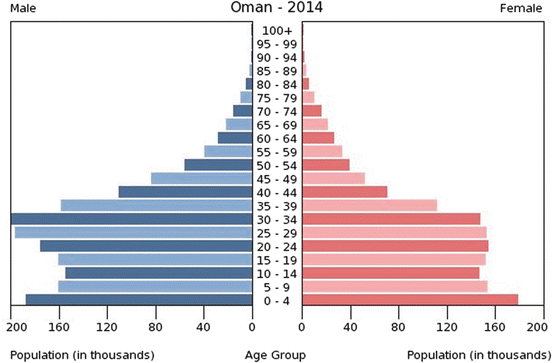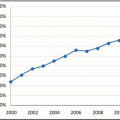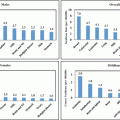Male
Female
Topography
Frequency
Percentage
Topography
Frequency
Percentage
Leukemia
58
9.8
Breast
147
24.8
Prostate
57
9.6
Thyroid
67
11.3
Colorectal
53
8.9
Non-Hodgkin lymphoma
37
6.2
Non-Hodgkin lymphoma
51
8.6
Colorectal
34
5.7
Stomach
49
8.2
Leukemia
30
5.1
Trachea, bronchus, lung
39
6.6
Cervix uteri
29
4.9
Bladder
29
4.9
Uterus
27
4.6
Liver
24
4
Stomach
23
3.9
Other skin
21
3.5
Hodgkin lymphoma
22
3.7
Hodgkin lymphoma
20
3.4
Other skin
20
3.4
Table 21.2
Five most common cancer among nationals of GCC states (1998–2007)
Oman | UAE | Bahrain | KSA | Qatar | Kuwait | |
|---|---|---|---|---|---|---|
Male | Stomach | Lung | Lung | Non-Hodgkin lymphoma | Lung | Colorectal |
Non-Hodgkin lymphoma | Colorectal | Colorectal | Colorectal | Colorectal | Non-Hodgkin lymphoma | |
Leukemia | Non-Hodgkin lymphoma | Prostate | Liver | Liver | Liver | |
Prostate | Prostate | Bladder | Leukemia | Leukemia | Leukemia | |
Lung | Leukemia | Leukemia | Lung | Bladder | Prostate | |
Female | Breast | Breast | Breast | Breast | Breast | Breast |
Thyroid | Thyroid | Colorectal | Thyroid | Thyroid | Colorectal | |
Cervix uteri | Leukemia | Lung | Colorectal | Colorectal | Thyroid | |
Leukemia | Colorectal | Thyroid | Non-Hodgkin lymphoma | Non-Hodgkin lymphoma | Non-Hodgkin lymphoma | |
Stomach | Cervix uteri | Ovary | Leukemia | Corpus uteri | Leukemia |
A significant feature of the demographic transition, therefore, is the change in disease epidemiology. The age adjusted annual incidence rates of cancer range from 80 to 110 per 100,000 population which is lower than some other countries in the region as well as globally [11]. By 2030, the number of new cancer cases worldwide is projected to rise by about 70 % [16]. In the region, the estimated increase is 68 % in just over a decade. According to GLOBOCAN estimates, Oman is facing an almost twofold increase in cancer incidence in the period 2008–2020. It is one of the most common causes of death in the Arab countries, ranking third in Oman. It accounts to 10.5 % of Ministry of Health (MOH) hospital deaths and is the top morbidity in noncommunicable diseases based on MOH hospitals’ discharges [17]. The sound health policies and strategies based on the primary health approach have led to significant changes of the morbidity and mortality patterns which show clear signs of transition in Oman, similar to those observed in the west. Based on the changing patterns and the anticipated rising numbers, Oman requested a WHO-IAEA joint Program of Action for Cancer Therapy (imPACT) in 2013 to effectively and efficiently address the cancer burden [18] (Fig. 21.1).


Fig. 21.1
Oman population pyramid 2014
Cancer patients in the country continue to present with advanced disease despite the universal coverage of health care services, availability of hospitals, and treatment facilities with utilization of the most advanced treatment modalities that includes surgery, chemotherapy, radiotherapy, hormonal, and targeted therapies. The delayed presentation can be a result of patient delay, a prolonged interval from the onset of the initial symptoms to seeking medical advice or can occur from a delay on the part of the health care provider or system itself resulting in a prolonged interval from patient presentation to initiation of treatment. Within the countries in transition, many personal, sociocultural, and economic factors cause late patient presentation. This has been attributed, namely to lack of awareness, cultural barriers, and limited screening programs. Understanding these barriers is crucial to optimizing interventional measures. Studies on breast cancer care have shown strong evidence that inferior or poor education level and less income status contribute to patient delay. In Oman, it is difficult to ascertain the level of poverty however the health gaps in level of education and income that existed in the past have been somehow narrowed. In some of those studies, the evidence for sociocultural variables is less strong. Other studies showed contradictory results in the association of personal characteristics (such as age, marital status, family history, presenting symptoms) and patient delay. There could be a reflection of the varying risks of bias in the studies or geographic variation in barriers to care due to multidimensional heterogeneity of the countries whose society, culture, and systems differ to some extent [19]. Breast cancer studies conducted in United Arab Emirates and other countries in the Middle East such as Qatar have generally shown below average knowledge scores on risk factors, warning signs, and methods for early detection [20, 21].
Research is therefore required in Oman through validated questionnaire to obtain baseline information on the current status of awareness that includes patients with and without delayed presentation as well as in identifying unknown risk factors. Although the literacy rates in Oman has gone up to 86 %, sociocultural context delays can be attributed to ignorance of initial signs and symptoms, use of alternative treatments, and fear of social consequences and stigma. Spiritual belief and religious observance can be a source of strength for patients and entail the concept of acceptance of God’s will which may prevent the patient from seeking medical advice thus hindering access to medical care. Inadequate numbers of female professional caregivers in the country restrict female patients with breast cancer, for example, from reaching for timely consultation. Furthermore, Omani women in general tend to neglect their problems, and concern for their health is at the least priority. Their duty is first to their husbands and children. Some have the misconception that surgical treatment may lead to loss of their femininity. Islamic healing is frequently sought as a choice by Omani women and their children who are afflicted with cancer. Traditional healers may in some occasions be the first “port call.” As in other Arab and Muslim countries, faith healing is one of the received forms of traditional treatment. This could be in the form of certain spiritual rituals or recitation of Quran verses and prayers in healing water as well as ingestion of herbs. One of the popular herbs which is grown and marketed in the region is the black seeds originating from the common fennel flower plant, the Nigella Sativa. This has been used historically from the time of the Christian era, by the ancient Egyptians and Greeks as an ailment for general health problems. Prophet Muhammad (peace upon him) has recommended its use by being quoted as saying “The Black Seed is a cure for all diseases except death” (Sahih Bukhari; 7–591). Drinking milk and urine of camels is a recognized practice for cancer treatment in Oman as well as in some of the neighboring countries. Cupping is also sought as a traditional form of treatment for cancer pain. Another type of pain therapy that was commonly practised in the past and still occasionally applied is the cauterization or burning of the skin at the site of pain or swelling called wassam. Frankincense oil, a resin from the bark of trees growing in the south of Oman has been used for years as treatment of anti-inflammatory and skin conditions as well as cancer. Recent research conducted in Oman showed promising results for its use as an anticancer drug [22, 23].
Stay updated, free articles. Join our Telegram channel

Full access? Get Clinical Tree





